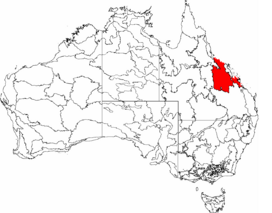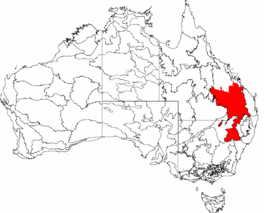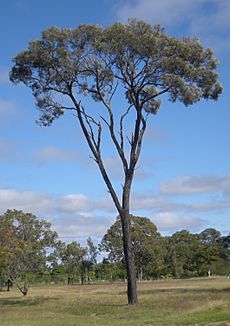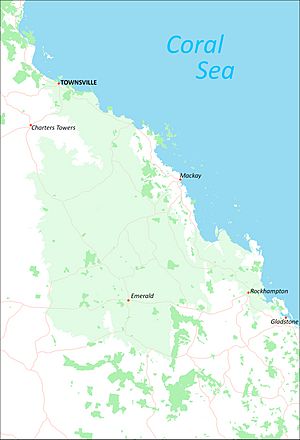Brigalow Belt facts for kids
Quick facts for kids Brigalow BeltBrigalow tropical savanna |
|
|---|---|

Brigalow Belt North (BBN) (IBRA
|
|

Brigalow Belt South (BBS) (IBRA)
|
|
| Ecology | |
| Realm | Australasian |
| Biome | tropical and subtropical grasslands, savannas, and shrublands |
| Borders |
List
|
| Geography | |
| Area | 408,242 km2 (157,623 sq mi) |
| Country | Australia |
| States | Queensland and New South Wales |
| Conservation | |
| Conservation status | Critical/endangered |
| Protected | 17,891 km² (4%) |
The Brigalow Belt is a large area of acacia woodlands and grasslands in Queensland, Australia. It stretches like a wide band between the wet tropical rainforests near the coast and the drier, semi-desert areas further inland.
This special region is divided into two main parts: the Brigalow Belt North (BBN) and the Brigalow Belt South (BBS). These two areas are part of Australia's 85 main natural regions, called bioregions. Together, they make up most of what is known as the Brigalow tropical savanna ecoregion, which is a type of habitat with grasslands and scattered trees.
Contents
Where is the Brigalow Belt?
The Northern Brigalow Belt covers a huge area, more than 13.5 million hectares. It starts just north of Townsville and reaches down to Emerald and Rockhampton, which are near the Tropic of Capricorn. The Southern Brigalow Belt then continues from there, stretching down to the border between Queensland and New South Wales. After that, the land changes into eucalyptus forests.
This big, interesting strip of land has many different types of landscapes. You can find rolling hills, rugged slopes, and flat plains. These plains are made of ancient sand, clay, and volcanic rock.
Important areas and rivers
The Northern Brigalow Belt includes areas like the Bowen Basin, which is known for its coal, and the fertile Peak Downs region. In the southern part, you'll find the huge Great Artesian Basin and the beautiful sandstone gorges of the Carnarvon Range. This range is part of the Great Dividing Range and separates the northern and southern parts of the Brigalow Belt. The southwestern side also includes the important farming area of Darling Downs.
Many important rivers flow through the Brigalow Belt. Most of them, like the big Fitzroy River system and the Belyando and Burdekin rivers, flow east towards the coast. However, rivers in the southwestern areas, such as the Maranoa, Warrego, and Condamine Rivers, flow west into the Murray–Darling basin.
Climate differences
The northern part of the Brigalow Belt has a tropical climate. This means it gets most of its rain in the summer and stays warm all year. South of the tropic, the winter is a bit cooler, and there's more rain throughout the year, not just in summer. All along the Brigalow Belt, the inland areas are drier, getting less than 500 mm of rain each year. The coastal areas are wetter, with more than 750 mm of rain.
Plants of the Brigalow Belt
The most famous tree here is the brigalow (Acacia harpophylla). This slender acacia tree is very good at handling dry conditions. It loves the clay soil and used to cover much of the area, especially the rich lowlands.
However, a lot of the brigalow forests have been cleared to make space for farms. Now, you'll mostly find eucalyptus woodlands on the higher slopes. These woodlands have trees like silver-leaved and narrow-leaved ironbarks, poplar box, blackbutt, and coolibah.
You can also find Dichanthium grasslands, which are another common habitat. In wetter valleys, there are small areas of thicker brigalow forests mixed with Casuarina cristata and Ooline trees. Sometimes, you might even find special places like vine thickets, wetlands, and softwood scrubs. These unique habitats are quite rare today because of development.
Areas like Isla Gorge and Blackdown Tableland in the Carnarvon Range have a particularly wide variety of these habitats. The Northern Brigalow Belt is considered one of Australia's 15 most important places for biodiversity, meaning it has a great variety of life.
Animals of the Brigalow Belt
This region is home to several interesting animals. You can find the unadorned rock-wallaby and the black-striped wallaby. The black-striped wallaby lives in the vine thickets, along with a special dung beetle that doesn't have wings, called Onthophagus apterus.
Two mammals that are in danger of disappearing, known as endangered species, also live in the Brigalow Belt:
- The bridled nail-tail wallaby can be found in Taunton and Idalia National Parks.
- The burrowing northern hairy-nosed wombat lives in the grasslands and eucalyptus forests of Epping Forest National Park.
Other animals here include birds like the black-throated finch and russet-tailed thrush. An interesting reptile that lives only in this area is the Fitzroy River turtle.
Challenges and protection
Sadly, much of the brigalow woodland has been cleared or greatly reduced. This has made it hard for some wildlife to survive, and some species have even disappeared from this area. Many of the remaining plant and animal communities are now threatened or endangered.
Clearing of brigalow and poplar box trees is still happening. While there are nature reserves that protect different habitats like brigalow and eucalyptus woodlands, grasslands, vine thickets, and wetlands, these parks are often located in the rocky uplands. The fertile lowlands, where brigalow forests once thrived, are still at risk from clearing.
The grasslands are also threatened by non-native grasses like buffelgrass and weeds such as Congress weed. Dams and weirs on the Dawson River also pose a threat to the natural environment.
Protected areas
Only a small part, just over two percent, of the Brigalow Belt is protected within national parks and other special areas. Some of the largest national parks in the Brigalow Belt include:
- Taunton National Park (the biggest at 115 km2)
- Epping Forest National Park
- Dipperu National Park
- Bowling Green Bay National Park
- Goodedulla National Park
- Chesterton Range National Park
- Homevale National Park
- Blackdown Tableland National Park
- Expedition National Park
- Carnarvon National Park
Smaller regions within the Brigalow Belt
The Brigalow Belt is further divided into smaller areas called IBRA subregions. These help scientists and conservationists study and protect the different parts of this large ecoregion.
Here are some of the subregions found in the Brigalow Belt North:
| IBRA regions and subregions: IBRA7 | |||||
|---|---|---|---|---|---|
| IBRA region / subregion | IBRA code | Area | States | Location in Australia | |
| Brigalow Belt North | BBN | 33,790,510 hectares (83,498,200 acres) | Qld |  |
|
| Townsville Plains | BBN01 | 763,495 ha (1,886,640 acres) | |||
| Bogie River Hills | BBN02 | 1,054,392 ha (2,605,460 acres) | |||
| Cape River Hills | BBN03 | 747,393 ha (1,846,850 acres) | |||
| Beucazon Hills | BBN04 | 95,821 ha (236,780 acres) | |||
| Wyarra Hills | BBN05 | 397,935 ha (983,320 acres) | |||
| Northern Bowen Basin | BBN06 | 1,316,957 ha (3,254,270 acres) | |||
| Belyando Downs | BBN07 | 1,772,127 ha (4,379,020 acres) | |||
| Upper Belyando Floodout | BBN08 | 466,275 ha (1,152,190 acres) | |||
| Anakie Inlier | BBN09 | 382,284 ha (944,640 acres) | |||
| Basalt Downs | BBN10 | 1,274,731 ha (3,149,930 acres) | |||
| Isaac-Comet Downs | BBN11 | 2,693,397 ha (6,655,530 acres) | |||
| Nebo-Connors Ranges | BBN12 | 449,269 ha (1,110,170 acres) | |||
| South Drummond Basin | BBN13 | 1,009,244 ha (2,493,900 acres) | |||
| Marlborough Plains | BBN14 | 1,250,611 ha (3,090,330 acres) | |||
And here are some of the subregions in the Brigalow Belt South:
| IBRA regions and subregions: IBRA7 | |||||
|---|---|---|---|---|---|
| IBRA region / subregion | IBRA code | Area | States | Location in Australia | |
| Brigalow Belt South | BBS | 27,219,776 hectares (67,261,530 acres) | Qld / NSW |  |
|
| Claude River Downs | BBS01 | 1,026,214 ha (2,535,830 acres) | |||
| Woorabinda | BBS02 | 749,785 ha (1,852,760 acres) | |||
| Boomer Range | BBS03 | 220,541 ha (544,970 acres) | |||
| Mount Morgan Ranges | BBS04 | 1,275,970 ha (3,153,000 acres) | |||
| Callide Creek Downs | BBS05 | 30,133 ha (74,460 acres) | |||
| Arcadia | BBS06 | 715,288 ha (1,767,520 acres) | |||
| Dawson River Downs | BBS07 | 982,807 ha (2,428,570 acres) | |||
| Banana-Auburn Ranges | BBS08 | 1,547,555 ha (3,824,090 acres) | |||
| Buckland Basalts | BBS09 | 281,306 ha (695,120 acres) | |||
| Carnarvon Ranges | BBS10 | 2,263,686 ha (5,593,690 acres) | |||
| Taroom Downs | BBS11 | 652,005 ha (1,611,140 acres) | |||
| Southern Downs | BBS12 | 4,264,666 ha (10,538,220 acres) | |||
| Barakula | BBS13 | 1,301,712 ha (3,216,600 acres) | |||
| Dulacca Downs | BBS14 | 162,442 ha (401,400 acres) | |||
| Weribone High | BBS15 | 966,510 ha (2,388,300 acres) | |||
| Tara Downs | BBS16 | 511,339 ha (1,263,550 acres) | |||
| Eastern Darling Downs | BBS17 | 1,697,945 ha (4,195,710 acres) | |||
| Inglewood Sandstones | BBS18 | 1,219,008 ha (3,012,230 acres) | |||
| Moonie-Commoron Floodout | BBS19 | 750,661 ha (1,854,920 acres) | |||
| Moonie-Barwon Interfluve | BBS20 | 765,231 ha (1,890,930 acres) | |||
| Northern Basalts | BBS21 | 624,671 ha (1,543,600 acres) | |||
| Northern Outwash | BBS22 | 700,241 ha (1,730,330 acres) | |||
| Pilliga Outwash | BBS23 | 535,392 ha (1,322,980 acres) | |||
| Pilliga | BBS24 | 1,732,137 ha (4,280,200 acres) | |||
| Liverpool Plains | BBS25 | 941,752 ha (2,327,120 acres) | |||
| Liverpool Range | BBS26 | 521,960 ha (1,289,800 acres) | |||
| Talbragar Valley | BBS27 | 203,894 ha (503,830 acres) | |||
| Narrandool | BBS28 | 303,754 ha (750,590 acres) | |||
- Sattler, P. S. and R. D. Williams (1999) (eds) The Conservation Status of Queensland’s Bioregional ecosystems. Environmental Protection Agency, Brisbane
See also
 In Spanish: Cinturón del Brigalow para niños
In Spanish: Cinturón del Brigalow para niños



